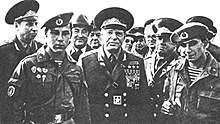Exercise Zapad-81
Exercise Zapad-81 (Russian: Запад-81, lit. 'West-81') was the largest military exercise ever to be carried out by the Soviet Union, according to NATO and US sources.[1] It was conducted from September 4, 1981 and lasted approximately 8 days. It was a joint operation including elements from all Soviet service branches and introduced several new systems such as the RSD-10 medium-range strategic missile (known often to the West as the SS-20 Saber) and the "Kiev" Project 1143 aircraft carrier.[2]

History
The exercise was first and foremost a show of force. Propaganda tapes were made of the large scale offensives concluding in a large victory parade. Apart from being a show of force to the NATO countries, the exercise was a large-scale demonstration of military capability in Poland. After the failure of reform communism in Poland during the seventies the People's Republic of Poland was in a state of crisis and civil unrest (Solidarność). Exercise Zapad included amphibious landings in Poland near Gdańsk, reminding Poles that the Soviet Union could resort to military force if that was deemed necessary.
The exercise was criticised by the US for violating the Helsinki Final Act of notification of military exercises.[3]
See also
References
- de Weydenthall et al., 1983
- (Message to the Congress Transmitting a Report and a Fact Sheet on Soviet Noncompliance With Arms Control Agreements, 1983).
External links
- de Weydenthall, Jan B., Bruce Porter, and Kevin Devlin, The Polish Drama: 1980-1982. Lexington, Mass.: D.C. Heath and Company 1983
- Parallel History Project, Information on the Complexes of the Strategic Offensive Forces of the USSR That Were Presented During the Exercise ZAPAD 81 -Original document
- Parallel History Project, Information on the Complexes of the Strategic Offensive Forces of the USSR That Were Presented During the Exercise ZAPAD 81 -Translation
- Message to the Congress Transmitting a Report and a Fact Sheet on Soviet Noncompliance With Arms Control Agreements, 1983
- Photos of the Zapad-81 drills, VisualRian (in Russian)
- Such soldier is Invincible (Russian: Такой солдат непобедим) (in Russian)